
The Royal Horticultural Society (RHS), founded in 1804 as the Horticultural Society of London, is the UK's leading gardening charity.

Tanacetum is a genus of about 160 species of flowering plants in the aster family, Asteraceae, native to many regions of the Northern Hemisphere. They are known commonly as tansies. The name tansy can refer specifically to Tanacetum vulgare, which may be called the common tansy or garden tansy for clarity. The generic name Tanacetum means 'immortality' in Botanical Latin, since tansy was once placed between the burial sheets of the dead to repel vermin.

Aeonium, the tree houseleeks, is a genus of about 35 species of succulent, subtropical plants of the family Crassulaceae. Many species are popular in horticulture. The genus name comes from the ancient Greek αἰώνιος / aiōnios (ageless). While most of them are native to the Canary Islands, some are found in Madeira, Cape Verde, Morocco, in East Africa and Yemen.
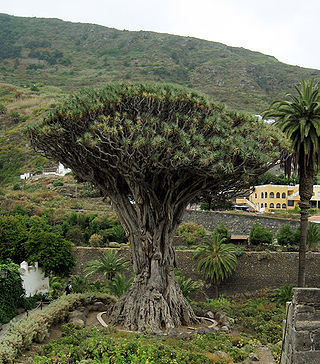
Dracaena draco, the Canary Islands dragon tree or drago, is a subtropical tree in the genus Dracaena, native to the Canary Islands, Cape Verde, Madeira, western Morocco, and possibly introduced into the Azores.

Sonchus is a genus of flowering plants in the tribe Cichorieae within the family Asteraceae and are commonly known as sow thistles. Sowthistles are annual, biennial or perennial herbs, with or without rhizomes and a few are even woody.

Pericallis is a small genus of 15 species of flowering plants in the family Asteraceae, native to the Canary Islands, Madeira and Azores. The genus includes herbaceous plants and small subshrubs. In the past, the genus was often included in either Cineraria or Senecio.

Genista stenopetala, the sweet broom, Easter broom or leafy broom, is a species of flowering plant in the legume family Fabaceae, native to the Canary Islands, on La Palma and Tenerife.

Argyranthemum is a genus of flowering plants belonging to the family Asteraceae. Members of this genus are sometimes also placed in the genus Chrysanthemum.

Echium wildpretii is a species of flowering plant in the family Boraginaceae. It is an herbaceous biennial plant that grows up to 3 m (10 ft) in height. The species is endemic to the Canary Islands, and is found mainly in the national park surrounding Mount Teide in Tenerife. The subspecies E. wildpretii subsp. trichosiphon occurs at high altitudes on the island of La Palma. The common names are tower of jewels, red bugloss, Tenerife bugloss or Mount Teide bugloss.

Caputia tomentosa, known as the woolly senecio and the matted caputia, is a perennial, succulent dwarf shrub of the Caputia genus that grows in the Cape Provinces of South Africa, usually between the 900 and 1200 meters elevation. It has been introduced to Myanmar. It has gained the Royal Horticultural Society's Award of Garden Merit as an ornamental.
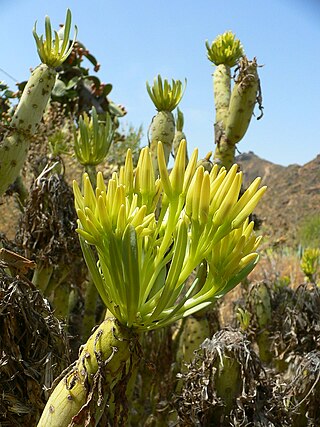
Kleinia is a genus of flowering plants in the sunflower family. Kleinia contains around 50 species and is distributed from Morocco and the Canary Islands, throughout Sub-Saharan Africa, the Arabian Peninsula, South Asia and Indochina. It is closely related to the genus Senecio but is distinguished primarily by having succulent stems or leaves.

Anthemideae is a tribe of flowering plants in the subfamily Asteroideae, which is part of the family Asteraceae. They are distributed worldwide, with concentrations in central Asia, the Mediterranean Basin, and southern Africa. Most species of plant known as chamomile belong to genera of this tribe.

Argyranthemum frutescens, known as Paris daisy, marguerite or marguerite daisy, is a perennial plant known for its flowers. It is native to the Canary Islands. Hybrids derived from this species are widely cultivated as ornamental plants in private gardens and public parks in many countries, and have naturalized in Italy and southern California. There are many cultivars, but the most common has white petals.
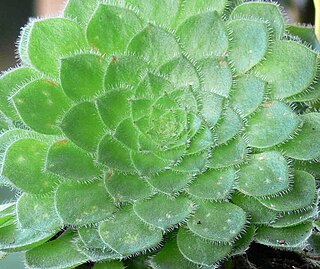
Aeonium tabuliforme, the flat-topped aeonium or saucer plant, is a species of succulent plant in the family Crassulaceae, native and endemic to Tenerife in the Canary Islands. It is low-growing, typically reaching about 5 cm high but up to 45 cm in diameter. It grows on moist, north-facing cliffs and ledges at low altitude. A mass of fleshy, hairy, bright green leaves in flat rosettes is produced on short unbranched stems, often on vertical surfaces. This species is short-lived and dies after flowering. Plants often take 3–4 years to flower, at which point they produce a tall (40–60 cm) raceme of yellow flowers.
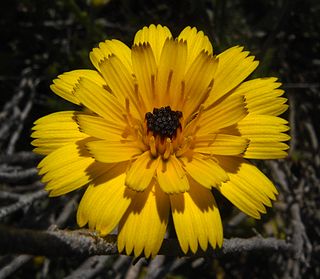
Tolpis is a genus of flowering plants in the tribe Cichorieae within the family Asteraceae. It is native to Africa, Southern Europe, the Middle East and Macaronesia. Many species are limited to the Canary Islands.
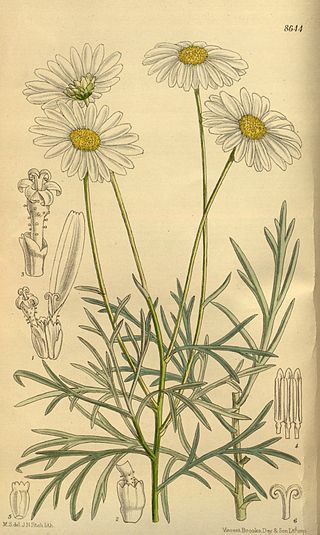
Argyranthemum foeniculaceum, called the Canary Island marguerite, is native to the Canary Islands,. It is widely cultivated as an ornamental and naturalized in California and Australia.

Garden marguerites, also known as marguerite daisies, are cultivars of plants in the subtribe Glebionidinae of the family Asteraceae, the great majority being hybrids created in cultivation. One of the genera belonging to the subtribe, Argyranthemum, was introduced into cultivation from the Canary Islands in the 18th century, and modern cultivars are mostly sold and grown under the genus name Argyranthemum or the species name Argyranthemum frutescens, although many are actually intergeneric hybrids. The first such hybrids involved species now placed in the genus Glebionis, but other crosses within the subtribe are known. Breeding has aimed at introducing flower heads in varied colours and shapes while retaining the shrubby habit of Argyranthemum. Garden marguerites are used as summer bedding or grown in containers. Most are only half-hardy. They can be trained into shapes such as pyramids or grown as standards.

Glebionidinae is a small subtribe of flowering plants in the tribe Anthemideae of the family Asteraceae. Its members include species used in the production of garden marguerites.

Argyranthemum maderense, called the Madeira marguerite, is a species of flowering plant in the genus Argyranthemum. In spite of its scientific and common names it is not native to Madeira, but to Lanzarote in the Canary Islands some 500 km away. It has gained the Royal Horticultural Society's Award of Garden Merit.


















